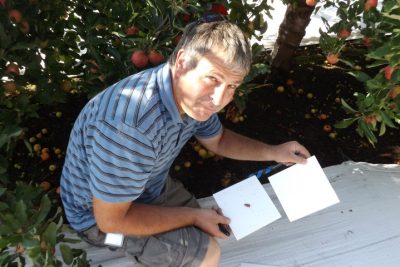Hastings Intermediate School - Murray Gosling

2015 | Developing strategies to control pest populations in horticulture
School: Hastings Intermediate School
Host: Plant & Food Research
Region: Hawkes Bay
Murray Gosling is a Team Leader of Technology at Hastings Intermediate School and is responsible for science throughout the school. He also runs a Science and Technology Academy for students.
Hawke’s Bay has a large horticultural industry including pipfruit, grapes and vegetable production. Developing a balance between pesticide use on fruit trees and encouraging natural predators to maintain low levels of pest numbers is desirable.
Murray was hosted by Dave Rogers (Scientist) and Jim Walker (Team Leader) in Hawke’s Bay. He worked alongside the Pipfruit and Winegrape Entomology team that focussed on developing pest control strategies for the horticultural sector. He worked with different scientists on trials with insect pheromones that are used to monitor pest populations and for control strategies such as mating disruption and lure and kill.
The placement gave Murray an opportunity to learn about insect biology, ecological principles, biological variation, designing experiments and trials, microscopic examination of insects, analysing data and scientific communication. It provided him with an overall understanding of how science underpins the horticultural exports and the important role of science within the community.
While at Plant and Food Research, Murray also had the opportunity to work with the Post-Harvest Group. Post Harvest is the stage of crop production following harvest from field to the consumer. The group work on a variety of trials to develop harvest and storage protocols that allow the fruit to be picked at the optimum time and stored at the appropriate requirements to ensure a high quality fruit is delivered to the consumer.
‘An apple is no longer just an apple’ – Murray now appreciates the time taken by scientists to develop new varieties from conception through to the consumer. He also has a fuller appreciation of the impact that insects have on fruit and the many different approaches to controlling these insects from the integrated spray programme through to the introduction of predator insects and pheromones.
The Science Teaching Leadership Programme (STLP) has allowed Murray to develop a range of connections with staff at Plant and Food Research, past teachers of the Teacher Fellowship Scheme within Hawke’s Bay, present teachers on the STLP and other sectors of the horticultural industry. The programme has invigorated Murray’s passion for science, given him a deeper understanding of the Nature of Science and provided him with a kete of skills that he can share with his colleagues and students when he returns to school.
Murray would like to acknowledge Jim Walker, Dave Rogers and Peter Lo from the Pipfruit and Winegrape Entomology team for their patience and the time they gave to explain the different trials. He also acknowledges Jason Johnston and his team from the Post Harvest group who allowed him to fully participate in their trials and gave him a greater appreciation of the apple production once picked. The staff at Plant and Food Research all made Murray welcome and he was able to glean new knowledge about a wide range of horticultural areas. He also would like to thank the staff at the Royal Society of New Zealand who provided background support to make this programme so beneficial for him.
